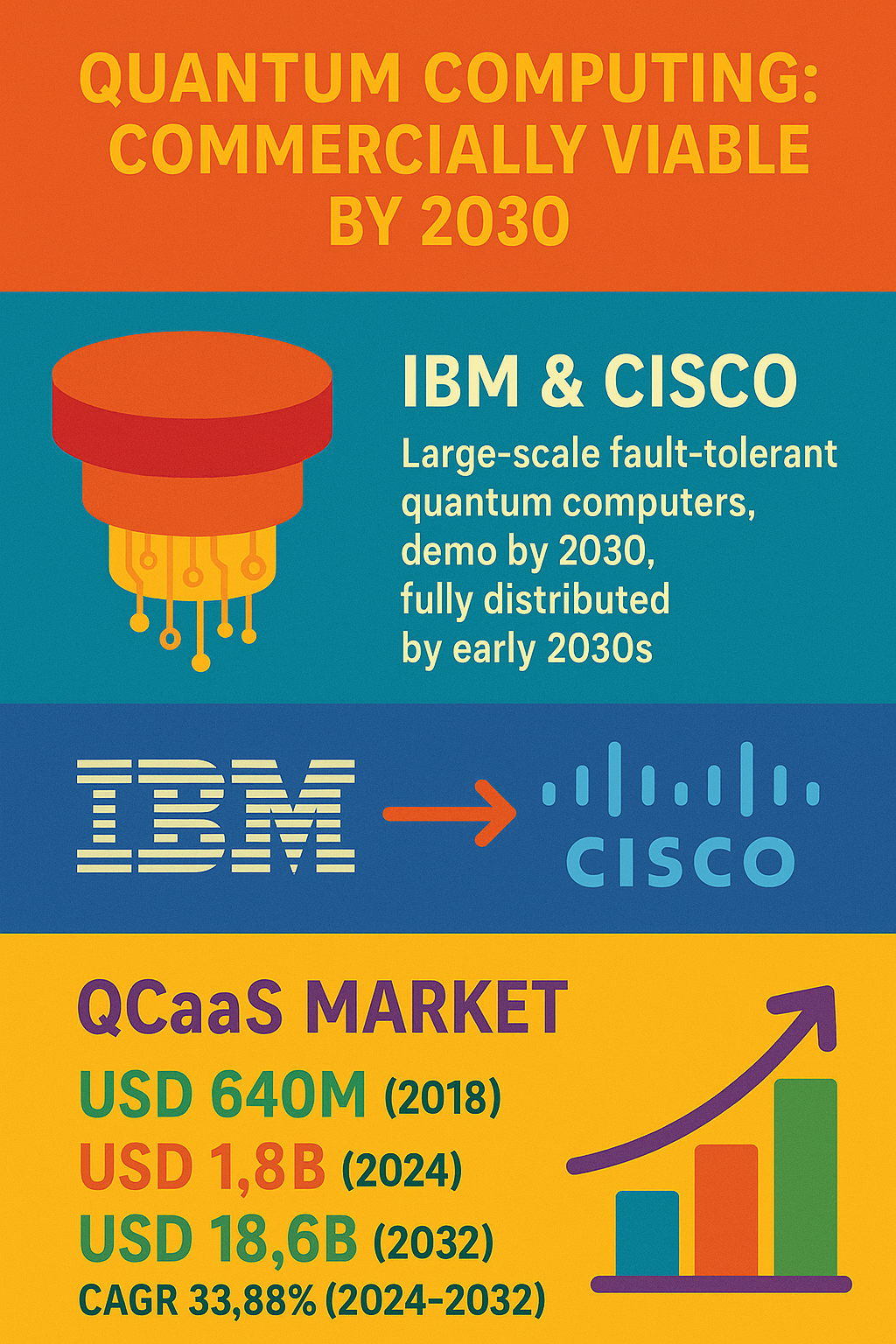The Emerging Role of Networked Quantum Computing in Shaping Future Industries
The evolution of quantum computing technology is progressing from isolated experimental systems toward fully networked, large-scale infrastructures. A weak but increasingly visible signal is the collaboration between technology leaders like IBM and Cisco to build distributed, fault-tolerant quantum computing networks. This shift from stand-alone quantum devices to interconnected quantum systems could redefine computational power, impacting multiple sectors including cybersecurity, logistics, and resource extraction by the 2030s.
What’s Changing?
Recent breakthroughs in quantum hardware, such as IonQ’s trapped ion devices and Xanadu’s photonic qubits, have brought room-temperature quantum computing closer to reality, possibly by 2026 (Forbes 2025). However, the landscape is rapidly expanding beyond just hardware improvements to system architecture and networking integration.
IBM and Cisco’s announced collaboration aims to establish a network of large-scale, fault-tolerant quantum computers with an initial project milestone targeted for 2030 and fully distributed quantum computing by the early 2030s (Quantum Pirates 2025). This initiative signals a paradigm shift from isolated quantum devices toward connected quantum systems acting in concert across geographies and organizations.
Simultaneously, more than half of surveyed enterprises expect to deploy post-quantum cryptographic algorithms securing production data by 2026, reflecting an urgent convergence of quantum advancements with cybersecurity priorities (HelpNetSecurity 2025).
Additional domain-specific applications underscore the disruptive potential of these emerging quantum networks. In mining, quantum computing may enable 20-30% efficiency gains by 2030 by solving previously intractable optimization problems such as supply chain logistics, ore body modeling, and energy consumption management (Discovery Alert 2025).
While widespread commercial quantum computing is still anticipated toward 2030, these networked efforts hint at an earlier inflection point where distributed quantum computing ecosystems might amplify the technology's impact well beyond standalone machines’ capabilities (Yahoo Finance 2025).
Why Is This Important?
The transition to networked quantum computing could radically alter how industries approach complex problem-solving tasks. Unlike classical distributed computing, quantum systems linked over secure and fault-tolerant networks may enable:
- Exponential scalability: Aggregating quantum devices across locations may overcome current qubit limitations, enabling unprecedented computational power.
- New cryptographic standards: Post-quantum cryptography adoption exemplifies how quantum advances impose immediate changes in cybersecurity protocols.
- Cross-sector collaboration: Quantum networks could foster novel partnerships where shared quantum resources facilitate breakthroughs in areas like drug discovery, climate modeling, and financial risk analysis.
The mining sector’s expected efficiency gains highlight tangible economic benefits but also imply significant shifts in operational models and capital allocation. Companies unprepared for a quantum-enabled disruption in their optimization or security systems risk losing competitive advantage or facing new vulnerabilities.
Moreover, quantum network development prompts regulatory and ethical considerations since the distributed nature of computing resources can blur jurisdictional controls, data sovereignty, and governance oversight.
Implications
Strategic planning must consider how a quantum computing network infrastructure could influence competitive landscapes and technology roadmaps over the next decade. Key implications include:
- Investment in Quantum Readiness: Organizations should accelerate efforts in workforce training, post-quantum cryptographic frameworks, and pilot projects with quantum-enabled supply chains.
- Infrastructure Collaboration: Partnerships with technology providers and participation in emerging quantum network consortiums may become vital for early access to distributed quantum resources.
- Risk Management: Understanding the cybersecurity risks introduced by quantum computing, both in terms of breaking current encryption and enabling new attack surfaces via interconnected systems, is critical.
- Policy and Governance: Governments and regulators might need to update data handling, export controls, and network security policies to address quantum network complexity and cross-border implications.
- Cross-Industry Innovation: Distributed quantum computing could catalyze joint ventures bridging sectors that share computationally intensive challenges, creating new business models and accelerating innovation cycles.
Organizations that monitor quantum networking developments and proactively adapt are likely to exploit its potential for both operational improvements and strategic intelligence advantages. Ignoring these signals risks being blindsided by emergent quantum-enabled competitors or disruptive business models.
Questions
- How will your current data infrastructure and security framework adapt to post-quantum cryptographic standards?
- What partnerships or consortiums exist today to position your organization within a future quantum computing network?
- Which complex optimization challenges in your industry could be transformed by access to distributed quantum computing?
- How might emerging quantum network regulations alter your international data governance and compliance strategies?
- What investments in workforce skills and R&D should you prioritize now to leverage quantum-enabled intelligence capabilities?
- How could your competitive landscape shift if key rivals gain early access to networked quantum resources?
Keywords
quantum computing; distributed quantum networks; post-quantum cryptography; fault-tolerant quantum computing; optimization algorithms; quantum mining applications
Bibliography
- 7 Quantum Computing Trends That Will Shape Every Industry in 2026. Forbes. https://www.forbes.com/sites/bernardmarr/2025/12/11/7-quantum-computing-trends-that-will-shape-every-industry-in-2026/
- Quantum Computing Applications in Mining Optimization Could Deliver 20-30% Efficiency Gains by 2030. Discovery Alert. https://discoveryalert.com.au/digital-transformation-mining-operations-2025-technology/
- More Than Half of Respondents Expect to Have at Least One Post Quantum Algorithm Protecting Production Data by 2026. HelpNetSecurity. https://www.helpnetsecurity.com/2025/12/04/tcg-post-quantum-readiness/
- IBM and Cisco Announced a Collaboration to Build a Network of Large-Scale, Fault-Tolerant Quantum Computers. Quantum Pirates. https://quantumpirates.substack.com/p/quantum-is-mission-critical-ibm-and
- Most Companies Point Toward 2030 Before Commercially Viable Quantum Computing is Available. Yahoo Finance. https://finance.yahoo.com/news/next-ai-giant-stock-could-120000498.html

